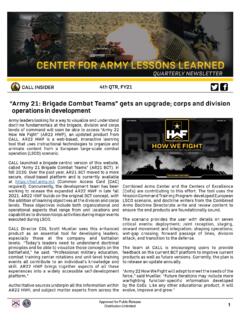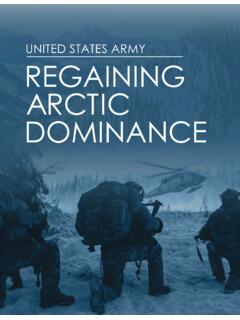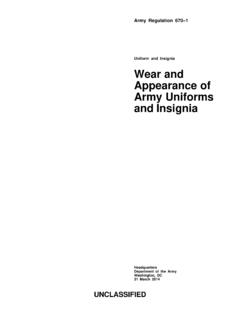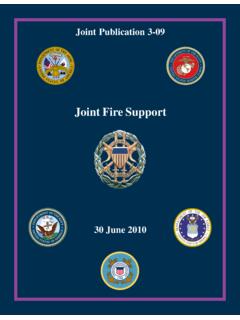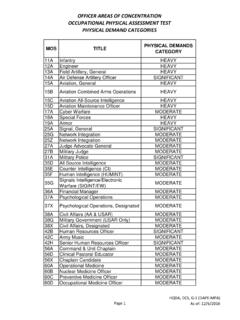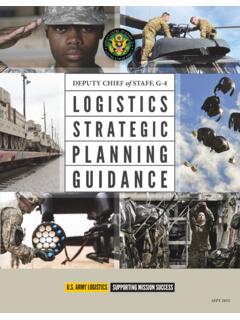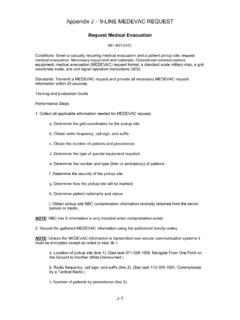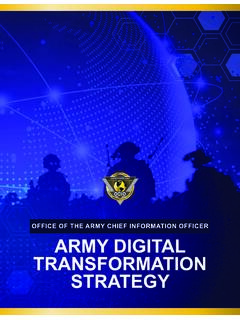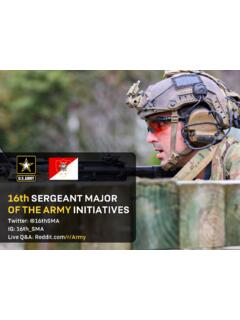Transcription of THE ARMY UNIFIED NETWORK 2021 PLAN
1 THE ARMY UNIFIED NETWORK PLANTHE ARMY UNIFIED NETWORK PLANENABLING MULTI-DOMAIN OPERATIONS2021 This page intentionally left OF CONTENTS Executive Summary ..iIntroduction ..1 The Need for a UNIFIED NETWORK Enabling the MDO-capable Army of 2028 ..3 Defining the Army UNIFIED NETWORK The Enabler for Multi-Domain Operations ..5 Strategic Approach ..6 Line of Effort #1: Establish the UNIFIED NETWORK Enabling Multi-Domain Operations ..7 Line of Effort #2: Posture the Force for Multi-Domain Operations ..9 Line of Effort #3: Security and Survivability Commander s Freedom of Action in Cyberspace ..10 Line of Effort #4: Reform Processes & Policies Improve Performance and Affordability ..11 Line of Effort #5: NETWORK Sustainment Sustain Enterprise and Tactical Networks ..12 Conclusion ..13 DISCLAIMERThe use of trade names in this document does not constitute an official endorsement or approval of the use of such commercial hardware or software.
2 Do not cite this document for the purpose of requests for all changes that affect this document to : LTC Tonya S. Robinson, DANI-NSP, DCS, G-6 Plans and EIEMA Portfolio Management Division Army UNIFIED NETWORK Plan is propelling the NETWORK from a perceived invisible asset to a weapons system supporting a Multi-Domain Operations (MDO) Way Point Force by 2028. The Army s UNIFIED NETWORK will deliver a survivable, secure, end-to-end capability that will enable the Army to operate as a part of the Joint/Coalition Force during competition, crisis or conflict and in all operational domains (sea, land, space, cyber, air).The Chief of Staff of the Army s White Paper on the Army s Transformation to Multi-Domain Operations and goal to have an MDO-capable Force by 2028 spotlights the critical need for the Army s UNIFIED NETWORK .
3 Decision dominance and overmatch ability are at the core of MDO, and the Army can only achieve this through resilient, secure, global NETWORK capability and capacity. Based on this, the Army UNIFIED NETWORK Plan aligns multiple, complex NETWORK modernization efforts into a single, coherent approach required to support across multiple lines of effort, the Army UNIFIED NETWORK Plan delivers a UNIFIED NETWORK for the Way Point Force of 2028 and then continuously modernizes as information technologies continue to evolve Army UNIFIED NETWORK Plan aligns with the Army Strategy s focus on building readiness, modernizing, reforming the Army, and strengthening alliances and partnerships. Existing tactical NETWORK modernization strategies and implementation plans nest and align with the Army Uni-fied NETWORK Plan.
4 Additionally, the Army UNIFIED NETWORK Plan parallels and enables the Army Campaign Plan 2019+ over multiple phases and time horizons:PHASE I: NEAR TERM (PRESENT-2024) SET THE UNIFIED NETWORKThis phase has begun with synchronizing the modernization of the Integrated Tactical NETWORK (ITN) and the Integrated Enterprise Networks (IEN). Primary efforts during this phase include: Decisive to this phase is the establishment of a standards-based security architecture built on zero-trust principles with an initial primary focus on SIPRNet modernization followed by critical capabilities on NIPR including pay, logistics, contracting, etc. The Army begins the implementation of a holistic approach to evolve the UNIFIED NETWORK over time that synchronizes multiple efforts and leverages emerging technologies such as software-defined and 5G and beyond wireless networks that also align to zero-trust principles.
5 The Army is following Office of the Under Secretary of Defense for wireless cellular networks as a critical technology for both tactical and enterprise NETWORK use. This will complement NETWORK consolidation and reduce non-wireless NETWORK dependency. This phase began with the accelerated movement of capabilities into cloud infrastructure coupled with swift divestment of legacy capabilities and processes. Key is the establishment of common data standards to enable emerging capabilities such as artificial intelligence (AI) and Machine Learning (ML). Ongoing development of the Mission Partner Environment (MPE) will continue as enterprise efforts establish a persistent capability and eliminates wasteful episodic The Army will continue aligning force structure to implement a Department of Defense Information NETWORK Operations (DODIN Ops) construct to operate, maintain, and defend the UNIFIED NETWORK in a contested and congested environment.
6 The Army must complete NETWORK Convergence across the enterprise to align a single Army service provider and improve NETWORK readiness, standardization, and interoperability; increase the Army s cybersecurity posture; and enable rapid DCO response. This convergence sets the conditions for the UNIFIED phase ends with the establishment of a standardized, integrated security architecture that sets the foundation for the UNIFIED NETWORK and enables the rapid deployment and immediate conduct of operations anywhere in the II: MID TERM (2025 - 2027) OPERATIONALIZE THE UNIFIED NETWORKThis phase begins in FY25 with the continued convergence of ITN and IEN capabilities. Primary efforts during this phase include: The completion of the DODIN Ops construct with supporting force structure that enables defense and operations of the UNIFIED NETWORK in a contested and congested environment.
7 This phase completes the establishment of hybrid cloud capabilities including tactical formations that accelerate Al/ML capability development. The Army will have established a persistent Mission Partner NETWORK (MPN) inclusive of all hardware, software, infrastructure, and people from the enterprise to the tactical edge including the employment at all Combat Training Centers (CTCs) and Mission Training phase ends when the UNIFIED NETWORK is fully postured to support the MDO Way Point force of III: FAR TERM (2028 AND BEYOND) CONTINUOUSLY MODERNIZE THE UNIFIED NETWORKThis phase begins on or about the start of FY28 when the Army UNIFIED NETWORK is fully postured operationally, technically, and organizationally to support the MDO Way Point force of 2028. Decisive in this phase is the full implementation of a holistic approach to modernize the UNIFIED NETWORK over time, leveraging emerging technologies while divesting of legacy, less secure, capabilities.
8 As the Army continues to integrate with the Joint /Coalition Force and mission partners, a number of leap-forward technological capabilities shape this phase. The initial focus areas for these technologies include: Dynamic and diverse transport, robust computing, and edge sensors Data to decisive action Robotics and autonomous operations Corresponding cybersecurity and resiliency capabilitiesGiven the rapid and consistent pace of change of Information Technology and the Cyber domain, there is no end to this phase modernization evolves to maturation of the UNIFIED NETWORK . It is a continuous process and there is no set end state for the UNIFIED Army UNIFIED NETWORK Plan is accompanied by the Army UNIFIED NETWORK Implementation, a Army Execution Order (EXORD) that decomposes the Framework into key tasks over near- and mid-term time horizons associated with pursuing the Lines of Effort (LOEs) and supporting objectives within the Framework.
9 As the leads for NETWORK integration and governance, the Chief Information Officer (CIO) and Deputy Chief of Staff (DCS), G-6 will use the Army UNIFIED NETWORK Implementation Plan to synchronize and assess efforts across the Total Force and all mission areas to set the UNIFIED NETWORK to support the MDO-capable Army of NEED FOR A UNIFIED NETWORK ENABLING THE MDO-CAPABLE ARMY OF 2028 The pace of technological advances, if not addressed, will dramatically erode the overmatch advantage we have enjoyed for decades. Technological advances enable the integration of space, cyber, information, and electronic warfare (EW) capabilities that can halt American power projection before it begins. artificial intelligence , autonomy, robotics, quantum computing, cellular wireless (5G and beyond), and Low Earth Orbit (LEO) Satellite will continue to change the character of operational campaigns, resulting in a battlefield that is faster, more lethal, and distributed.
10 We can no longer assume that the homeland is a sanctuary, or consider the global commons is under this context that the Army has begun its transformation to an MDO-capable Force by 2028 and an MDO-Ready Force by 2035 it is an operational imperative for the Army and, more importantly, the Joint/Coalition his White Paper, the CSA lays out several tenets that drive the need for a UNIFIED NETWORK that is resilient, trusted, maneuverable, and defendable one that from a complete Doctrine, Organization, Training, Materiel (capability), Leadership, Policy, and Facility (DOTML-PF), delivers a UNIFIED NETWORK that enables rapid, global deployment. The UNIFIED NETWORK enables Army Formations to operate in a highly contested and congested operational environment with speed and at global range to enable decision dominance and maintain and foremost, the Army will enable the Joint/Coalition Force to maneuver and prevail, from competition through conflict, with a calibrated force posture of multi-domain capabilities that provide overmatch through speed + range + convergence at the point of need for decision conflicts of tomorrow will be non-linear and contested at all echelons and on a global scale, with the homeland no longer a sanctuary free from adversary kinetic or non-kinetic attacks.
